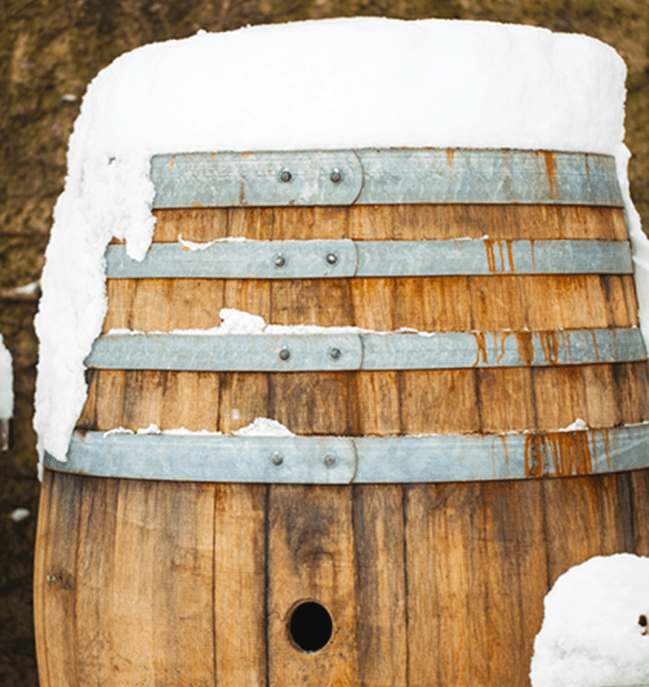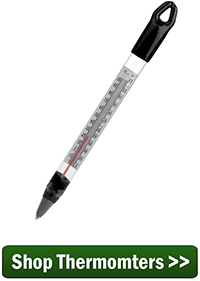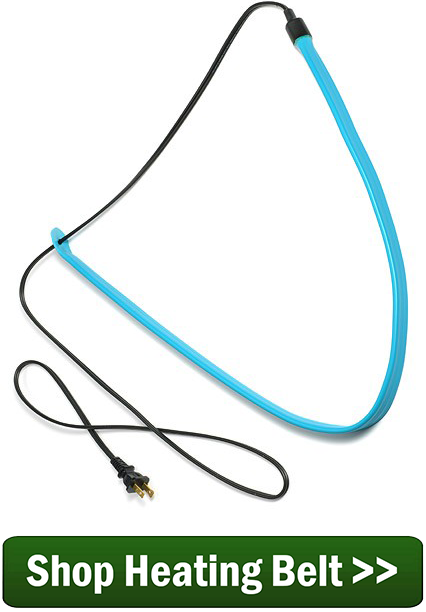 I live in Louisiana in the south. Is it too late to make wine? Is there a problem making wine in cold weather? I have a lot of fruit left from the summer.
I live in Louisiana in the south. Is it too late to make wine? Is there a problem making wine in cold weather? I have a lot of fruit left from the summer.
Mildred M. — LA
—–
Hello Mildred,
You can make wine all throughout the year without any problems. The only real issue is that you need to control your fermentation temperature. For a wine fermentation to go as it should, the temperature range needs to be between 70° and 75°F. If you get out of this temperature range, issues can arise, but beyond this, there is nothing wrong with making wine in cold weather.
If the temperature gets below 70° the wine yeast will start to go dormant. They can slow down to the point of not being active at all. This is known as a stuck fermentation. Or, the wine yeast may not start up at all. Warm the fermentation up to 70°F., and you will start to see activity.
This temperature range is true for most wine yeast except for a few exceptions like Red Star Pasteur Blanc wine yeast which can ferment at cooler temperatures without stopping completely. However, it will ferment very slowly.
If the fermentation temperature starts to get over 75°F., then the wine yeast can start to produce funny off-flavors and aromas. The resulting wine will not have a clean taste.
Beyond these concerns, there is absolutely no reason why you shouldn’t be making wine in cold weather, even in the middle of winter. Just have a means of controlling the fermentation temperature.
If you are not sure that you can keep the fermentation in this range, you may want to look into tying an artificial source of heat. It needs to be a very gentle source of heat. Most items you find around the house such as heating blankets are too warm and will put the fermentation well over the 75°F. This is just as bad, if not worse, as having the fermentation too cool.
If a fermentation is too cool there is no permanent damage done to the wine. It’s just not fermenting. Warm it up and the fermentation will start up again. But, if the fermentation becomes overly heated, you can encourage bacteria growth and the production of unwanted enzymes in the wine. Nothing harmful, but it will make the wine taste off or fowl, and it will be irreversible.
can encourage bacteria growth and the production of unwanted enzymes in the wine. Nothing harmful, but it will make the wine taste off or fowl, and it will be irreversible.
You may want to consider getting a thermometer for monitoring temperature when making wine in cold weather. Putting your hands on the side of the fermenter and guessing is not good enough. If you are making temperature adjustments you should have a fermentation thermometer of some type.
A heating belt is one way to warm up your fermentation a few degrees. This works good for cold basement situations or when fermenting in some cold corner of the house. It’s basically a strap that goes around the fermenter and plugs into an outlet. The only downfall is that there is no way to adjust its temperature of this belt.
Something else you can do when making wine in cold weather is to get a thermostat power switch. This is a power-interrupt thermostat with a temperature sensor. It plugs into an outlet and controls the power to a heating source – such as a heating blanket or the heating belt – base on the temperature to which it has been set.
Mildred, I say if you got the fruit, then go ahead and make the wine. The month doesn’t matter. Making wine in cold weather is easy to do. It’s simply a matter of taking control of the fermentation’s temperature.
Happy Wine Making,
Ed Kraus
—–
Ed Kraus is a 3rd generation home brewer/winemaker and has been an owner of E. C. Kraus since 1999. He has been helping individuals make better wine and beer for over 25 years.

Another trick I have used is an aquarium heater. It’s preset for 78º, but I have found my pail of must running about 75º to 76º with the thermometer. I have had 3 batches of them going at a time on occasion in cool weather and all have came out fine.
I live in Canada where the weather is quite cool,so my house is also cool-around 67-68.I use a heating pad held on by a belt. Usually set at low,or medium if required. Works great for me.
I also live in Canada and found the perfect place for making wine in winter. I have a walk in shower in my bathroom where I put my primary fermenter, close the bathroom door and leave the light on to create warmth. Works great!
Sir
Winter is a great time for me to make wine simply because the temperature is constant. Have bought a thermostat. The tortoise has lost his heat mat and my dog ‘donated’ his blanket to the greater cause. My problem time is summer because our house is hard to keep to a constant temperature then. I’ve lost more than one batch because of it.
How do I cool a batch quickly and return it to 70 degrees if the temperature spikes?
I live in Stirling in Scotland. Thanks. Peter
Peter, there a few different methods you can try to cool down the temperature of a fermentation. The article posted below will explain what you can do.
Cool Down Fermentation
https://blog.eckraus.com/wine-fermentation-temperature-is-too-high
I built myself a box out of plywood, insulated it with 2″ Styrofoam insulation then installed a 100 watt light bulb on a thermostatically controlled switch that kelp the temperature exactly 70 degrees throughout the whole process, during the winter months. The whole system cost me less than $25.00, and I have used it for many years. The biggest problem now is finding the incandescent lightbulbs.
Wow! That’s a great idea!
My husband and I are gardeners and start our seeds indoors. We have a propagation mat for the seeds which we found works great for our wine making also. We just set the thermostat for the appropriate setting, wrap a large towel around the fermentation bucket to keep the heat in and you’re good to go. Works great every time!
I live in south Louisiana also and when I make mead and kombucha I make / store in my pantry And wrap a medium weight towel around it. The temp stays pretty constant in summer or winter. Works well for me.
Barbara G
Help! Just started a kit fermentation and for five days it was top to bottom in the 75-79 range. Then just yesterday, when fermentation was at its most active, the temperature rose to 85! There was no change in temperature on the outside of the fermenter. It is now at 79 with an outside room temperature @ 74. I am concerned that the high fermentation temperature the last two days may have caused permanent damage to the wine. A further question…how much of an increase in temperature occurs during normal fermentation? This kit is an expensive Can Sauv that I love. Thanks for any advice you can send my way. Your newsletters are great!
I am considering making jalapeno wine. All the recipes I find have raisins or grape juice, surely you c a n make pepper wine without adding raisins or grape concentrate.
Damian, the reason the recipes are suggesting using either of these products is to add body to the wine. If you make the recipe without using one of them,your resulting wine may have very little body.
I live in northern Minnesota. My basement is in the mid 60’s year around. I use a Crock-Pot with a little water that my one gallon fermenter fits. I use an Auber Instruments SLY-2372 variable temperature controller that controls the electric power to the low temperature setting of the Crock-Pot. The controller has a thermocouple that is set in the water along the side of the fermenter. This setup controls fermentation temperature at 72 degrees. The temperature can be varied throughout the process as needed.
Question, how much wine does a wine kit make? Thank you.
Keith, I can only speak for the wine kits that we carry, they each make 6-gallons of wine.
I use 2 FastFermenters placed in a room in the garage that houses the furnace. Temperature is a consistent 80-85C. Wine comes out great every time. Reds only.
Actually, fermentation temperature depends on the strain of yeast used. I am currently fermenting a batch of Blaufrankisch. The yeast I am using (MT) has a temperature range of 59-90 degrees F. I prefer a long cool fermentation especially for white wines.Bottom line, no, not all yeasts go dorment under 70 degrees F. It depends on the yeast.